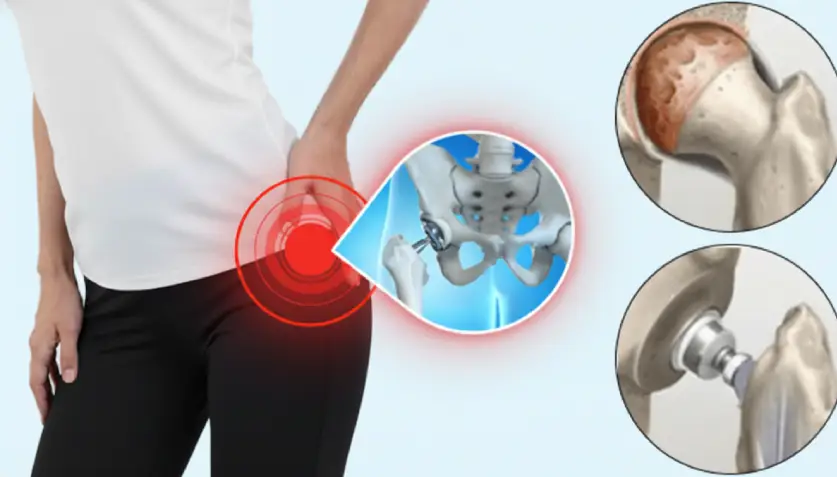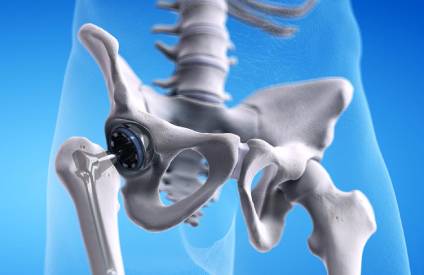
Restoring Mobility & Quality of Life Through Advanced Hip Care
As an orthopaedic surgeon, I’ve seen how hip pain can hold people back from the activities they love—simple things like walking, sitting comfortably, or climbing stairs. My goal is always to help patients regain their independence using evidence-based, minimally invasive surgical solutions.
Hip Replacement & Revision Surgery can dramatically improve comfort, mobility, and joint function. Whether you need a primary total hip replacement or a revision surgery, my focus is on achieving long-term success with faster recovery and natural joint movement.
Understanding Hip Replacement Surgery
Hip replacement involves removing damaged cartilage and bone from the hip joint and replacing them with precision-engineered implants. It’s often the best option for people with osteoarthritis, avascular necrosis, or post-traumatic arthritis.
By using advanced implant materials and minimally invasive approaches, patients experience less pain, reduced hospital stays, and quicker return to activities.
Quick Highlights
- Removes pain caused by arthritis or joint degeneration
- Restores full hip motion and stability
- Long-lasting implants for everyday use


Revision Hip Replacement Surgery — A Second Chance at Comfort
When a previous hip replacement fails due to wear, infection, or instability, revision surgery becomes necessary. I carefully evaluate each case through advanced imaging to determine the safest and most effective corrective approach.
Modern revision techniques allow the removal of old implants and placement of new, more durable components—helping restore function and relieve discomfort.
Quick Highlights
- Corrects failed or worn implants
- Eliminates chronic pain & instability
- Restores confidence in daily movement
Advanced Surgical Techniques for Precision Results
I perform both anterior and posterior hip replacements depending on the patient’s anatomy and medical needs. Using computer-assisted and image-guided technology ensures each implant is positioned perfectly.
These modern techniques minimize tissue damage, shorten hospital stays, and allow for faster rehabilitation.
Quick Highlights
- Computer-assisted implant alignment
- Smaller incisions with faster healing
- Safer procedures with minimal blood loss
Recovery After Hip Replacement Surgery
After surgery, rehabilitation is key to restoring movement and strength. My team and I design customized recovery plans to suit each patient’s lifestyle and goals.
Most patients resume basic activities within a few days and return to normal routines within 6–8 weeks, supported by physiotherapy and guided exercises.
Quick Highlights
- Walk within 24–48 hours post-surgery
- Personalized physiotherapy plan
- Return to work in 4–6 weeks
When to Consider Hip Replacement
I recommend surgery only when conservative treatments—like medication, injections, or lifestyle modifications—no longer provide relief. Persistent pain, difficulty walking, and loss of balance are major indicators.
Early intervention can prevent worsening joint damage and allow smoother recovery outcomes.
Quick Highlights
- Chronic pain despite medication
- Reduced walking or sitting tolerance
- X-ray showing severe joint damage
Implant Technology & Material Innovation
Today’s implants are designed to mimic natural joint motion. I use high-performance ceramic, metal, or cross-linked polyethylene materials depending on patient activity levels.
These implants provide exceptional durability, often lasting 20 years or more with proper care, allowing active lifestyles without restriction.
Quick Highlights
- Durable, biocompatible materials
- Natural joint feel & smooth motion
- Proven 15–20 year longevity
Hip Replacement for Active Lifestyles
Younger patients often worry about resuming sports or fitness routines. With advanced techniques and modern implants, returning to low-impact activities is entirely achievable.
I focus on restoring confidence and mobility—helping patients return to walking, swimming, and cycling safely post-surgery.
Quick Highlights
- Return to light sports in 3 months
- Strengthens leg muscles for endurance
- Enhances joint coordination
Managing Pain and Discomfort Effectively
Pain control is a top priority. I use multimodal pain management combining regional anesthesia, targeted medication, and physical therapy to ensure a comfortable recovery.
Most patients experience only mild soreness, managed easily through short-term medications and ice therapy.
Quick Highlights
- Modern pain-relief protocols
- Quick tapering of medication
- Comfortable early mobility
Long-Term Follow-Up and Care
Hip replacement success depends on consistent follow-up. I advise yearly check-ups to monitor implant condition, gait, and muscle strength.
Lifestyle adjustments—such as maintaining healthy weight and avoiding high-impact sports—help ensure implant longevity.
Quick Highlights
- Annual check-ups with imaging
- Prevent wear & tear through care
- Continued exercise support
Conclusion – Your Journey to Pain-Free Movement
As your surgeon, my mission is to restore your mobility safely and effectively. Whether it’s a total hip replacement or a revision surgery, every step—from diagnosis to rehabilitation—is designed around your comfort and long-term joint health.
If hip pain is limiting your daily life, let’s discuss your options. Together, we’ll create a treatment plan that helps you return to the active, independent lifestyle you deserve.
Frequently Asked Questions
A well-done hip replacement can last 15–20 years or more. Longevity depends on your bone health, implant material, and activity level. Regular follow-ups help ensure long-term stability and comfort.
Most of my patients start walking with support within 24 hours. Gradual physiotherapy helps regain strength and balance. By 4–6 weeks, most can walk independently without assistance.
The cost usually ranges between ₹3 lakh – ₹6 lakh depending on implant type, hospital setup, and overall medical condition. I always provide a personalized estimate after your evaluation.
Revision surgery is recommended when the previous implant loosens, wears out, or causes pain. It helps restore hip function, stability, and improves quality of life significantly.
Yes, most patients regain excellent motion and flexibility with proper rehabilitation. Regular exercises and lifestyle care help you move naturally and live pain-free again.

